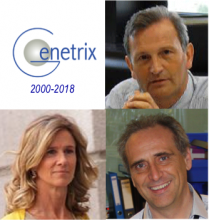CNB pioneered in Spain the biomedical public-private partnership with the foundation of its Department of Immunology and Oncology (DIO). Genetrix, a Spin-off started at the DIO, 18 years after its foundation lands its largest success. Tigenix, a company born from Genetrix subsidiaries and external partners, sold for over 500 million Euro.
Genetrix: a successful umbrella business strategy
Since its foundation 18 years ago, Genetrix has carried out an ambitious business development strategy that includes a fruitful policy of acquisitions and sales with other pharmaceutical companies. In January 2018 the multinational Takeda presented a public offer for share acquisition for the prize of 520 million Euro. This operation, which ends by start July 2018, culminates the activity of Genetrix as a private promoter of biomedicine in Spain. It represents a milestone of the success of the company and its subsidiary projects.
Genetrix has been one of the scarce Spanish examples of successful basic-clinical collaboration. Paired with an adequate business development, it has managed to successfully re-invent itself, adapting to the needs and mechanisms to access the market. This is its story.
Origin
Genetrix SL was constituted in November 2000 as a spin-off of the Department of Immunology and Oncology (DIO) of the Spanish National Center for Biotechnology of CSIC (CNB-CSIC), in Madrid. Founded by Prof. Carlos Martínez-Alonso in November 1996, the department came into being as a pioneering initiative between CSIC and the multinational Pharmacia-Upjohn, establishing a prominent case of public-private research collaboration in Spain.
The three founding members of Genetrix were Carlos Martínez Alonso himself, together with Cristina Garmendia and Antonio Bernad. Garmendia and Bernad met during their Ph.D. in the laboratory of Prof. Margarita Salas, a recognized Spanish biochemist (and former pupil of Severo Ochoa). Numerous conversations during that period hinted about their mutual interest to get involved into the biotech business. Eventually, they and their colleagues decided to start a company further deepening into the collaboration already running between the public and private sectors at the DIO.
The development
Genetrix, in which the CSIC was also invited to participate, was initially conceived as a company dedicated to the development and commercialization of intellectual property of the know-how emerging from the DIO not prioritized by Pharmacia-Upjohn. As a safeguard of the commercial interests of the multinational, Pharmacia-Upjohn would retain a first-refusal option in later stages of development; that is, the priority of purchase in sales offered to third parties.
Of the three founder members, Garmendia, having completed an MBA, took responsibility for the financial design and selection of the initial investors. For their part, Martínez-Alonso and Bernad selected the initial projects and were architects of the strategy for the R+D Department, as well as liaison contacts with the DIO. A first financial round was executed and Garmendia was designated as President and CEO of Genetrix SL. The inestimable support of the director of the CNB at that time, Mariano Esteban contributed towards finding a physical location at CNB, where temporary laboratories would be located at the so-called Pilot Plant. The offices of Genetrix were established at the Madrid Technological Park, in front of the CNB. Their adventure had started.
Once it had sprung into existence, the company structured in two main areas: Molecular Therapy, and Cellular Therapy. The Molecular Therapy Area focused on the development of humanized antibodies for intervention in human pathological conditions, particularly in connection to inflammatory processes. For its part, the Cellular Therapy Area concentrated on the use of mesenchymal stem cells derived from adipose tissue (ASC), for the treatment of conditions with exacerbated inflammation and impaired healing capacity.
Finance-driven adjustments
The needs associated to the following higher-level financial rounds, pushed towards a modification of the business strategy. The implemented changes would entail the development of more advanced projects in subsidiary companies. The required flexibilization resulted in the creation of a new company, from the Cellular Therapy Area, in 2004. The newly created company, Cellerix SA, continued its focus on developing human ASC for disease treatment, as the Cellular Therapy Area had done before.

The company ecosystem around Genetrix has substantially grown since its foundation in the year 2000
Valuable new financial partners were incorporated by the creation of Cellerix. These included Ventech, LSP, Ysios, Roche Genera, AyG and Novartis. Finally, in February 2011, Cellerix SA announced positive results in the phase II clinical trial ADMIRE-CO. This project addressed the treatment of Crohn’s disease patients suffering from complex perianal fistulas. The condition it focused on, while not life-threatening, substantially reduces patient quality of life. No adequate treatment was available, making this a virgin market to be exploited.
Not long after this advance, in June 2011, Cellerix SA merged with TiGenix NV, a Belgian company listed on the Brussels stock market (NYSE Euronext Brussels: TIG). Together, they constituted TiGenix Living Medicines. The merger process valued yet Cellerix SA at 58 million Euro, even before the decisive phase III of ADMIRE-CO launch in 2012.
In July 2015, Genetrix, the original parent company, strengthened the alliance constituted four years before: it reached an agreement for the acquisition by TiGenix of its subsidiary company CoreTherapix, a Cell Therapy Cardiovascular Company. Genetrix would receive a total of 267 million Euro, conditioned to the fulfilment of several clinical and commercial accomplishments. In addition, Genetrix would receive a direct full down payment of 25 million Euro for each ongoing pipeline product that reached the market.
Touching the market
In July 2016, The Lancet published the early (24-week post-treatment) positive results of ADMIRE-CO (phase III). An exhaustive follow-up of the patients to 104 weeks post-treatment confirmed the stability and safety of the treatment, paving its way towards the market. At that time, TiGenix initiated an official application to commercialize Cx601, which would receive the denomination Alofisel (Darvadstrocel). TiGenix signed an agreement with the multinational Takeda Pharmaceutical Company Limited to transfer all exclusive rights of Cx601 for worldwide commercialization, except in the USA. Thereafter, in December 2016, TiGenix was incorporated into the Nasdaq index.
In December 2017, the Committee for Medicinal Products for Human Use (CHMP) of the European Medicines Agency (EMA), in conjunction with the Committee for Advanced Therapies (CAT), adopted a positive opinion recommending the authorization of the compound Cx601 (Alofisel). Definitive authorization ensued in March 2018. In January 2018, Takeda presented a public offer for share acquisition (OPA) of TiGenix. The offer valued TiGenix at 520 million Euro.
Take-home message
Over its 18 years of life, Genetrix has carried out an ambitious project to promote and reinforce the private-public interface in Spanish biomedicine. On the way, Genetrix has created, directly and indirectly, more than 200 specialized jobs. Genetrix will continue to participate in decisions regarding the projects in which it still participates, and which are in expansion, as are Tigenix-Takeda and Sygnis-Expedeon.
The success of projects like the Genetrix Spin-off depends on many factors, and doubtlessly the selection of the initial investors was key. The previous public-private collaboration at CNB, the reputation of the founding members and a solid financial plan were essential to the success of this venture. All this together, allowed translating research results into drugs making it to the market. In the process, the story of the company and its success was written. Genetrix has been part of the successful avant-garde of companies populating an area almost non-existent in Spain at its time.

Genetrix team in the year 2005, with the largest successes still to come
Founding members:

Carlos Martínez Alonso
Prof. Carlos Martínez Alonso (Villasimpliz, 1950), is a chemist and researcher in immunology with a long national and international career in the study of lymphocyte biology and its implications in cell migration and autoimmunity. He is awarded with the DuPont Prize for Science; the Carmen y Severo Ochoa; the Rey Jaime I Award for Scientific Research; the Lilly de Investigación Preclínica; the Spanish National Award of Medicine “Gregorio Marañon”, and The International Award to Science and Technology of the Government of Mexico among others. He has presided the European Molecular Biology Organization (EMBO), the Spanish National Research Council (CSIC) and been Secretary of State for Research in the Ministry of Science and Innovation, among other relevant positions. He is a member of the European Molecular Biology Organization (EMBO) and was a member of its Scientific Council, of the Academia Europaea, Dr. Honoris Causa by several universities and member of the editorial committee of various international prestigious journals.
Cristina Garmendia
Dr. Cristina Garmendia (San Sebastián, 1962), is a biologist and businessperson, notorious for her nomination in the year 2008 as Minister of Science and Innovation of the Spanish Government, under President José Luis Rodríguez Zapatero. After the end of her Ministry, Garmendia returned to her entrepreneurial activities in the private sector. Dr. Garmendia has participated as member of multiple business associations and scientific/advisory boards. She currently presides over the Fundación Cotec para la Innovación, a private foundation promoting innovation as an engine for economic and social improvement.
Antonio Bernad
Prof. Antonio Bernad (Zaragoza 1961), is a biochemist and researcher in the field of stem cells. He has researched at institutions of excellence including CIEMAT, CNB, CNIC and the Harvard Medical School. At the CNB, he built a research team focused on the biology of hematopoietic and mesenchymal stem cells and their use in tissue engineering. While at the CNIC, he has addressed the field of adult cardiac progenitor cells (CPC) and their regulation, homeostasis, and biosafety in cell therapy. He was Director of the Regenerative Cardiology Department, and coordinated the European project CARE-MI for clinical evaluation of CPC in allogeneic transplant. Since 2013, he is back at DIO (CNB-CSIC) as group leader of the Adult Stem Cell team.
Article previously published at: SOMM Alliance Website with the collaboration of Prof. Antonio Bernad.


